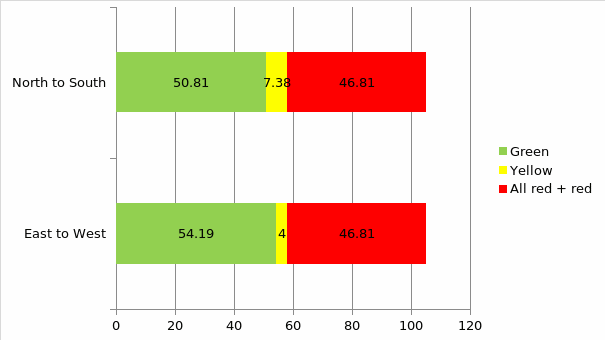Discussion
The flow of traffic is a problem that most cities in the world face. Despite the efforts that have been made, the waiting time in traffic is still a major problem. Therefore, it is important to estimate the probability of waiting at a particular traffic signal (Li and Shimamoto 6). This paper seeks to set the traffic light in such a way that the waiting time for each car is the same. In the calculations, it will be assumed that a complete rotation of a cycle will be red, followed by green, yellow and all red (Valvano 105). The cycle length will be the time it takes to complete the full cycle of the four indications. The cycle length is 1.75minutes, an equivalent of 105 seconds. The solution to the problem of allocating time will be solved in 5 distinctive steps as shown below.
Step 1
The first step will entail determining the volume for critical lane and the total volume. The first critical lane is the movement from East to West. The volume for this lane is 80 cars per hour (Dolgui, Morel and Pereira 83). The second critical lane is the movement from North to South. The total volume of this lane is 75 cars per hour. The total critical volume is 155 cars per hour (80 + 75).
Step 2
The second step is to equate the sum of indications to the length of the cycle. The calculations are presented below.
East to West
- REW + GEW + YEW + AREW = 105 seconds
North to South
- RNS + GNS + YNS + ARNS = 105 seconds
Thus, the sum of time allocated to the two directions should be equivalent to the cycle length.
- REW + GEW + YEW + AREW + RNS + GNS + YNS + ARNS = 105 seconds
Step 3
The third step entails estimating the percentage of cycle length to be allocated to each direction (Bade and Parkin 203). This will give the amount of time that is allocated for each green period. The formula is presented below.
- Green = (volume of critical lane / total critical volume) * cycle length
East to west
Green
- = (80 / 155) * 105
- = 54.19 seconds
North to South
- = (75 / 155) * 105
- = 50.81 seconds
Step 4
In this case, the waiting time will be measured by the sum of all red (AR) and red (R) because the vehicles do not move during these indications (Liu, Wang and Yang 56).
Waiting time for East to West
- REW + GEW + YEW + AREW = 105 seconds
- REW + 54.19 + YEW + AREW = 105 seconds
- REW + YEW + AREW = 105 seconds – 54.19 seconds
- REW + YEW + AREW = 50.81 seconds
- REW + AREW = 50.81 seconds – YEW
- Let REW + AREW be X, therefore
- X = 50.81 – YEW
Waiting time for North to South
- RNS + GNS + YNS + ARNS = 105 seconds
- RNS + 50.81 + YNS + ARNS = 105 seconds
- RNS + YNS + ARNS = 105 seconds – 50.81 seconds
- RNS + YNS + ARNS = 54.19 seconds
- RNS + ARNS = 54.19 seconds – YNS
- But RNS + ARNS = REW + AREW = X
Therefore,
- X = 54.19 – YNS
Solve the two equations simultaneously
- 50.81 – YEW = 54.19 – YNS
- YNS – YEW = 54.19 – 50.81
- YNS – YEW = 3.38
- YNS = 3.38 + YEW
Substitute in the equations above
- X = 54.19 – YNS
- X = 50.81 – YEW
Substitute YNS = 3.38 + YEW
- X = 54.19 – (3.38 + YEW)
- X = 50.81 – YEW
- X = 50.81 – YEW
If we let YEW be 4 seconds, then YNS will be 7.38 seconds and X will be 46.81. Therefore, the waiting time for each car will be 46.81 second.
Step 5
The graph presented below shows an illustration of a timing diagram (Mankiw 341).

Works Cited
Bade, Robin and Michael Parkin. Essential Foundations of Economics, USA: Pearson Education, 2013. Print.
Dolgui, Alexandre, Gerard Morel, and Carlos Pereira. Information Control Problems in Manufacturing 2006: A Proceedings Volume from the 12th IFAC Conference, 17-19 May 2006, Saint-Etienne, New York: Elsevier, 2006. Print.
Li, Chunxiao, and Shigeru Shimamoto. “Dynamic Traffic Light Control Scheme for Reducing CO2 Emissions Employing ETC Technology”. International Journal of Managing Public Sector Information and Communication Technologies (IJMPICT), 2.1 (2012): 1-12. Print.
Liu, Chunfeng, Leizhen Wang, and Aimin Yang. Information Computing and Applications: Third International Conference, ICICA 2012, Chengde, China, September 14-16, 2012. Proceedings, Part 2, New York: Springer, 2012. Print.
Mankiw, Gregory. Principles of Economics, USA: South-Western Cengage Learning, 2011. Print.
Valvano, Jonathan. Introduction to Embedded Systems: Interfacing to the Freescale 9S12, Boston: Cengage Learning, 2009. Print.